
|
It will approach to Sun down to 0.1 a.u. on Jan. 31. In the Northern Hemisphere, it will appear in the morning sky at 9 mag in mid February, then it stays observable while the comet will be fading. In the Southern Hemisphere, it stays observable for a long time, although it is not observable from mid January to mid February.
Date(TT) R.A. (2000) Decl. Delta r Elong. m1 Best Time(A, h)
Jan. 28 21 19.18 -24 10.8 0.977 0.186 10 3.9 18:51 ( 71,-13)
Feb. 4 20 30.17 -8 4.5 0.965 0.213 12 4.6 5:30 (276, -6)
|
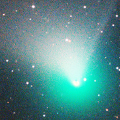
|
Now it is very bright as 5.0 mag (Jan. 28, Osamu Miyazaki). It will approach to Earth down to 0.29 a.u. in February, and it brightens up to 5 mag. In the Northern Hemisphere, it stays observable in excellent condition for a long time. In the Southern Hemisphere, it is not observable until early February.
Date(TT) R.A. (2000) Decl. Delta r Elong. m1 Best Time(A, h)
Jan. 28 13 59.07 73 53.6 0.325 1.139 110 5.1 5:34 (180, 52)
Feb. 4 5 29.10 57 48.1 0.294 1.169 122 5.0 20:27 (180, 70)
|

|
Now it is very bright as 8.6 mag (Jan. 25, Chris Wyatt). It is observable at 8 mag for a long time from 2022 to 2023. In the Southern Hemisphere, it stays observable for a long time. In the Northern Hemisphere, it is not observable until summer.
Date(TT) R.A. (2000) Decl. Delta r Elong. m1 Best Time(A, h)
Jan. 28 22 12.35 -70 45.2 2.263 1.866 54 7.8 18:51 ( 21,-28)
Feb. 4 23 18.24 -69 43.5 2.240 1.892 56 7.8 18:57 ( 21,-25)
|

|
It brightened very rapidly. Now it is very bright as 9.9 mag (Jan. 27, Osamu Miyazaki). It stays 9-10 mag until March. In the Northern Hemisphere, it stays observable for a long time. But it locates low until spring. In the Southern Hemisphere, it is not observable until June.
Date(TT) R.A. (2000) Decl. Delta r Elong. m1 Best Time(A, h)
Jan. 28 19 5.63 58 42.5 1.646 1.757 79 9.5 5:34 (219, 37)
Feb. 4 20 4.23 58 16.8 1.700 1.745 75 9.5 5:30 (218, 32)
|

|
Now it is 10.6 mag (Jan. 28, Osamu Miyazaki). It stays bright as 10 mag for a long time until autumn. In the Northern Hemisphere, it stays observable in good condition until autumn. In the Southern Hemipshere, it stays unobservable until summer.
Date(TT) R.A. (2000) Decl. Delta r Elong. m1 Best Time(A, h)
Jan. 28 1 28.44 59 34.0 2.184 2.506 97 9.7 18:51 (152, 60)
Feb. 4 1 30.61 54 49.7 2.263 2.471 90 9.7 18:57 (140, 59)
|

|
It brightened very rapidly. Now it is very bright as 9.6 mag (Jan. 25, Toshihiko Ikemura, Hirohisa Sato). It stays 10-12 mag until February. In the Northern Hemisphere, it stays observable in good condition. Appearing in the evening sky also in the Southern Hemisphere. It stays observable in excellent condition after this.
Date(TT) R.A. (2000) Decl. Delta r Elong. m1 Best Time(A, h)
Jan. 28 4 13.43 58 40.7 0.564 1.344 117 11.3 19:48 (180, 67)
Feb. 4 4 50.37 47 8.0 0.576 1.363 119 11.5 19:56 (180, 79)
|

|
It brightened up to 8.3 mag in last winter (Jan. 6, 2022, Toshiyuki Takahashi). Now it is fading. But it is bright as 11.1 mag still now (Jan. 14, Thomas Lehmann).
Date(TT) R.A. (2000) Decl. Delta r Elong. m1 Best Time(A, h)
Jan. 28 9 40.32 -34 9.0 4.274 4.911 125 11.5 1:14 ( 0, 21)
Feb. 4 9 35.29 -34 40.2 4.278 4.952 128 11.6 0:42 ( 0, 20)
|

|
Now it is 13.2 mag (Nov. 27, Ken-ichi Kadota). It is expected to brighten up to 11 mag in 2023. In the Southern Hemisphere, it stays observable in good condition for a long time, although it became unobservable temporarily from November to January. In the Northern Hemisphere, it is not observable until 2024 autumn.
Date(TT) R.A. (2000) Decl. Delta r Elong. m1 Best Time(A, h)
Jan. 28 18 55.12 -29 43.2 4.081 3.228 26 11.7 5:34 (303, -5)
Feb. 4 19 3.22 -30 57.4 4.002 3.208 31 11.6 5:30 (306, -3)
|

|
Now it is 11.4 mag (Jan. 27, Toshihiko Ikemura, Hirohisa Sato). It stays 11-12 mag until spring.
Date(TT) R.A. (2000) Decl. Delta r Elong. m1 Best Time(A, h)
Jan. 28 15 43.15 -16 45.2 1.707 1.655 70 11.7 5:34 (331, 33)
Feb. 4 16 0.32 -17 27.7 1.671 1.674 73 11.8 5:30 (333, 33)
|
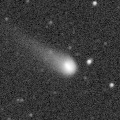
|
Now it is 12.3 mag (Jan. 25, Osamu Miyazaki). It stays 12 mag until summer. It stays observable in good condition for a long time.
Date(TT) R.A. (2000) Decl. Delta r Elong. m1 Best Time(A, h)
Jan. 28 13 38.37 1 32.4 3.285 3.666 104 12.3 5:12 ( 0, 56)
Feb. 4 13 31.84 1 4.6 3.152 3.657 113 12.2 4:38 ( 0, 56)
|
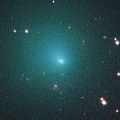
|
Now it is bright as 11.4 mag (Dec. 14, Jose Guilherme de S. Aguiar). It will be fading after this. In the Southern Hemisphere, it stays observable in good condition for a long time, although it became unobservable temporarily from December to January. In the Northern Hemisphere, it is not observable until spring when it fades down to 15 mag.
Date(TT) R.A. (2000) Decl. Delta r Elong. m1 Best Time(A, h)
Jan. 28 19 25.63 -38 14.9 2.612 1.775 25 12.6 5:34 (307,-15)
Feb. 4 19 24.56 -38 28.2 2.580 1.816 31 12.8 5:30 (310,-11)
|

|
Now it is bright as 12.9 mag (Jan. 27, Toshihiko Ikemura, Hirohisa Sato). It stays 13 mag until spring. It stays observable in good condition for a while after this.
Date(TT) R.A. (2000) Decl. Delta r Elong. m1 Best Time(A, h)
Jan. 28 15 27.55 2 9.0 4.740 4.659 79 12.9 5:34 (324, 51)
Feb. 4 15 31.83 3 5.4 4.660 4.682 85 12.9 5:30 (330, 54)
|

|
Now it is 13.0 mag (Jan. 21, Ken-ichi Kadota). It stays bright as 13 mag and observable in excellent condition until February.
Date(TT) R.A. (2000) Decl. Delta r Elong. m1 Best Time(A, h)
Jan. 28 8 32.69 13 17.7 0.927 1.910 174 13.1 0:07 ( 0, 68)
Feb. 4 8 28.87 14 41.9 0.949 1.927 170 13.2 23:31 ( 0, 70)
|
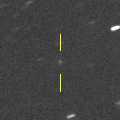
|
It brightens up to 13 mag in winter. But the condition is bad. Appearing in the morning sky in the Southern Hemisphere. It is not observable until May in the Northern Hemisphere.
Date(TT) R.A. (2000) Decl. Delta r Elong. m1 Best Time(A, h)
Jan. 28 19 6.72 -25 49.2 2.452 1.589 22 13.3 5:34 (299, -4)
Feb. 4 19 30.05 -25 31.0 2.436 1.593 24 13.2 5:30 (298, -4)
|

|
It brightened in major outburst in late November. Now it is bright as 11.6 mag (Jan. 18, Toshihiko Ikemura, Hirohisa Sato).
Date(TT) R.A. (2000) Decl. Delta r Elong. m1 Best Time(A, h)
Jan. 28 6 23.64 29 10.8 5.214 6.066 147 13.5 21:54 ( 0, 84)
Feb. 4 6 21.07 29 3.3 5.283 6.068 139 13.5 21:24 ( 0, 84)
|

|
Now it is 13.8 mag (Jan. 20, Ken-ichi Kadota). The brightness evolution is slower than originally predicted. It stays 14 mag until summer. In the Northern Hemisphere, it stays observable in good condition until spring. In the Southern Hemisphere, it stays observable in good condition for a long time.
Date(TT) R.A. (2000) Decl. Delta r Elong. m1 Best Time(A, h)
Jan. 28 3 15.66 -11 17.6 2.013 2.314 94 13.6 18:51 ( 1, 44)
Feb. 4 3 15.21 -12 42.3 2.085 2.276 88 13.6 18:57 ( 12, 41)
|
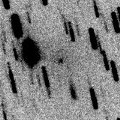
|
Tiny comet, but it will approach to Sun down to 0.8 a.u. in January, and to Earth down to 0.6 a.u. in March. It will brighten up to 14 mag from January to March. In the Southern Hemisphere, it stays observable in good condition for a long time. In the Northern Hemisphere, it is not observable now. It will become observable in early March. It has not been observed since late October.
Date(TT) R.A. (2000) Decl. Delta r Elong. m1 Best Time(A, h)
Jan. 28 22 37.23 -59 41.5 1.135 0.847 46 14.1 18:51 ( 30,-21)
Feb. 4 23 21.89 -62 44.5 1.016 0.875 51 14.0 18:57 ( 27,-21)
|

|
Now it is 14.7 mag (Jan. 13, ATLAS Chile). It stays 14 mag in 2023. In the Southern Hemisphere, it stays observable in good condition for a long time. It locates somewhat low in the Northern Hemisphere.
Date(TT) R.A. (2000) Decl. Delta r Elong. m1 Best Time(A, h)
Jan. 28 2 58.75 -16 42.2 3.298 3.428 89 14.4 18:51 ( 7, 38)
Feb. 4 2 51.64 -15 11.2 3.403 3.407 81 14.5 18:57 ( 19, 38)
|
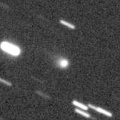
|
Now it is 14.7 mag (Jan. 11, Hiroshi Abe). It is expected to brighten up to 8 mag in July. It will be getting lower after this. And it will be unobservable in February. In the Southern Hemisphere, it will be observable in excellent condition at the high light. In the Northern Hemisphere, it becomes very low at the high lihght.
Date(TT) R.A. (2000) Decl. Delta r Elong. m1 Best Time(A, h)
Jan. 28 0 23.36 -13 19.3 3.299 2.832 53 14.6 18:51 ( 49, 26)
Feb. 4 0 22.11 -13 4.2 3.340 2.762 46 14.5 18:57 ( 56, 21)
|

|
It brightened up to 9.3 mag in early summer (June 5, Chris Wyatt). Now it is fading. It has already faded down to 15.0 mag (Jan. 14, Thomas Lehmann). In the Southen Hemisphere, it stays observable in good condition for a long time. It became observable also in the Northern Hemisphere. But it stays locating low for a while.
Date(TT) R.A. (2000) Decl. Delta r Elong. m1 Best Time(A, h)
Jan. 28 7 33.02 -35 14.5 2.631 3.285 124 14.6 23:02 ( 0, 20)
Feb. 4 7 20.28 -32 34.0 2.690 3.349 124 14.7 22:22 ( 0, 23)
|

|
Appearing in the morning sky. Now it is 15.7 mag (Jan. 26, ATLAS Chile). It will brighten very rapidly. It is expected to be observable at 11 mag in excellent condition from spring to summer.
Date(TT) R.A. (2000) Decl. Delta r Elong. m1 Best Time(A, h)
Jan. 28 16 35.65 -25 33.3 2.539 2.159 56 15.1 5:34 (323, 19)
Feb. 4 16 51.76 -25 36.3 2.453 2.138 59 14.7 5:30 (325, 20)
|
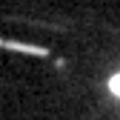
|
Now it is 15.8 mag (Jan. 24, Toshihiko Ikemura, Hirohisa Sato). It will brighten rapidly up to 14 mag and will be observable in excellent condition in spring. In the Northern Hemisphere, it is observable in good condition in winter, but it becomes somewhat low in spring.
Date(TT) R.A. (2000) Decl. Delta r Elong. m1 Best Time(A, h)
Jan. 28 14 15.84 -11 46.9 2.145 2.388 91 15.1 5:34 (355, 43)
Feb. 4 14 21.89 -13 18.4 2.050 2.380 97 15.0 5:27 ( 0, 42)
|
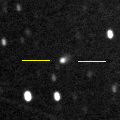
|
Now it is 14.8 mag (Jan. 26, iTelescope Observatory, Siding Spring). It is expected to brighten up to 7 mag in early 2024. In the Southern Hemisphere, it stays observable in good condition for a long time. It locates low in the Northern Hemisphere.
Date(TT) R.A. (2000) Decl. Delta r Elong. m1 Best Time(A, h)
Jan. 28 5 22.99 -37 38.2 4.436 4.823 107 15.1 20:53 ( 0, 17)
Feb. 4 5 19.32 -37 2.1 4.419 4.757 104 15.0 20:22 ( 0, 18)
|

|
Now it is 15.6 mag (Jan. 16, Ken-ichi Kadota). The brightness evolution is slower than originally expected. It stays 14-15 mag for a long time. Appearing in the morning sky also in the Southern Hemisphere.
Date(TT) R.A. (2000) Decl. Delta r Elong. m1 Best Time(A, h)
Jan. 28 17 59.52 -6 55.6 3.925 3.240 40 15.0 5:34 (294, 20)
Feb. 4 18 2.70 -5 20.2 3.865 3.269 46 15.0 5:30 (297, 25)
|
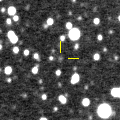
|
Now it is 15.5 mag (Jan. 24, ATLAS Chile). It will brighten up to 13 mag from 2024 to 2025. It is observable in excllent condition in the Southern Hemisphere. It locates low in the Northern Hemisphere.
Date(TT) R.A. (2000) Decl. Delta r Elong. m1 Best Time(A, h)
Jan. 28 9 2.61 -39 28.9 6.089 6.661 121 15.1 0:37 ( 0, 15)
Feb. 4 8 59.64 -39 28.0 6.026 6.628 124 15.1 0:06 ( 0, 15)
|

|
Now it is 14.8 mag (Dec. 8, ATLAS Chile). Now it is not observable. It will become observable again in late March in the Southern Hemisphere, or in late May in the Northern Hemisphere.
Date(TT) R.A. (2000) Decl. Delta r Elong. m1 Best Time(A, h)
Jan. 28 21 35.33 -21 23.5 4.149 3.200 13 15.2 18:51 ( 70, -9)
Feb. 4 21 46.12 -20 30.3 4.177 3.210 9 15.2 18:57 ( 74,-13)
|
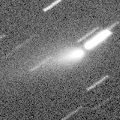
|
Outburst occured in early October, and it brightened up to 9.9 mag (Oct. 14, Thomas Lehmann). It is bright as 13.1 mag still now (Jan. 14, Thomas Lehmann). It stays observable only until February in the Southern Hemisphere, or until March in the Northern Hemisphere.
Date(TT) R.A. (2000) Decl. Delta r Elong. m1 Best Time(A, h)
Jan. 28 0 4.95 -7 11.0 2.611 2.136 51 15.3 18:51 ( 57, 28)
Feb. 4 0 17.61 -5 27.4 2.736 2.196 47 15.7 18:57 ( 63, 25)
|
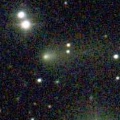
|
Now it is 14.4 mag (Jan. 19, Toshihiko Ikemura, Hirohisa Sato). It will be fading after this, and it will be fainter than 18 mag in spring. It is observable in good condition in the Northern Hemisphere. It locates somewhat low in the Southern Hemisphere. It is brighter than this ephemeris recently.
Date(TT) R.A. (2000) Decl. Delta r Elong. m1 Best Time(A, h)
Jan. 28 7 36.53 24 18.8 1.638 2.599 164 15.5 23:07 ( 0, 79)
Feb. 4 7 32.09 24 46.4 1.688 2.620 156 15.7 22:35 ( 0, 80)
|

|
Now it is 14.6 mag (Jan. 24, Purple Mountain Observatory, XuYi Station). It stays 15-16 mag and observable in good condition until spring. It is brighter than this ephemeris recently.
Date(TT) R.A. (2000) Decl. Delta r Elong. m1 Best Time(A, h)
Jan. 28 9 33.24 23 52.5 2.407 3.372 166 15.7 1:07 ( 0, 79)
Feb. 4 9 31.01 24 52.7 2.395 3.370 170 15.8 0:38 ( 0, 80)
|

|
Now it is 15.5 mag (Jan. 13, ATLAS Chile). It was expected to brighten up to 13 mag in 2022 spring. But actually, it was fainter than originally expected. In the Southern Hemisphere, it stays observable in good condition for a long time. In the Northern Hemisphere, it stays extremely low for a while.
Date(TT) R.A. (2000) Decl. Delta r Elong. m1 Best Time(A, h)
Jan. 28 2 14.69 -31 20.8 3.919 3.793 75 15.9 18:51 ( 15, 22)
Feb. 4 2 13.44 -29 4.8 4.046 3.829 70 16.0 18:57 ( 24, 22)
|

|
Now it is 15.7 mag (Jan. 26, ATLAS Chile). It is expected to brighten up to 12-13 mag from 2024 to 2025.
Date(TT) R.A. (2000) Decl. Delta r Elong. m1 Best Time(A, h)
Jan. 28 10 4.76 -18 51.7 5.473 6.232 137 16.1 1:39 ( 0, 36)
Feb. 4 9 58.71 -18 16.3 5.371 6.188 143 16.1 1:05 ( 0, 37)
|

|
It brightened rapidly. Now it is 16.3 mag (Jan. 26, Purple Mountain Observatory, XuYi Station). It is observable at 16 mag in good condition in winter.
Date(TT) R.A. (2000) Decl. Delta r Elong. m1 Best Time(A, h)
Jan. 28 10 16.45 17 39.4 0.996 1.941 156 16.1 1:50 ( 0, 72)
Feb. 4 10 13.22 18 39.7 0.994 1.961 164 16.2 1:20 ( 0, 73)
|
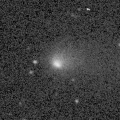
|
It brightened up to 14.6 mag in autumn (Oct. 19, Toshihiko Ikemura, Hirohisa Sato). Now it is fading. It has already faded down to 17.1 mag (Jan. 19, Toshihiko Ikemura, Hirohisa Sato). It will be fainter than 18 mag in spring.
Date(TT) R.A. (2000) Decl. Delta r Elong. m1 Best Time(A, h)
Jan. 28 2 14.19 6 48.2 2.087 2.248 86 16.2 18:51 ( 32, 58)
Feb. 4 2 24.46 7 52.7 2.183 2.265 81 16.3 18:57 ( 42, 56)
|
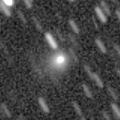
|
It brightened by 6 mag in outburst in early August up to 14.6 mag (Aug. 13, ATLAS-MLO, Mauna Loa). It has already faded down to 16.6 mag (Jan. 9, Ken-ichi Kadota). It will be extremely low after this.
Date(TT) R.A. (2000) Decl. Delta r Elong. m1 Best Time(A, h)
Jan. 28 23 24.93 -6 12.7 2.327 1.727 42 16.2 18:51 ( 66, 22)
Feb. 4 23 43.98 -5 24.7 2.375 1.735 39 16.3 18:57 ( 69, 19)
|

|
It brightened up to 12.7 mag in last year (Feb. 27, 2022, Jose Guilherme de S. Aguiar). Now it is fading. Appearing in the morning sky. In the Southern Hemisphere, it stays observable until summer when it becomes fainter than 18 mag. It locates low in the Northern Hemisphere.
Date(TT) R.A. (2000) Decl. Delta r Elong. m1 Best Time(A, h)
Jan. 28 17 59.14 -25 45.6 3.272 2.565 37 16.3 5:34 (309, 7)
Feb. 4 18 12.24 -25 49.6 3.237 2.588 41 16.4 5:30 (310, 9)
|
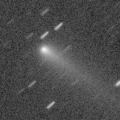
|
It brightened up to 14.1 mag in autumn (Nov. 14, Thomas Lehmann). Now it is fading. It has already faded down to 15.8 mag (Jan. 21, Toshihiko Ikemura, Hirohisa Sato). It stays observable in excellent condition for a while.
Date(TT) R.A. (2000) Decl. Delta r Elong. m1 Best Time(A, h)
Jan. 28 2 24.70 30 34.5 2.241 2.544 96 16.3 18:51 ( 73, 78)
Feb. 4 2 33.14 31 18.3 2.344 2.563 91 16.4 18:57 ( 84, 73)
|

|
It will brighten up to 16 mag in 2023. In the Southern Hemisphere, it stays observable in good condition for a long time. In the Northern Hemisphere, it will never be observable again. It has not been observed since 2022 July.
Date(TT) R.A. (2000) Decl. Delta r Elong. m1 Best Time(A, h)
Jan. 28 15 51.65 -67 7.2 3.516 3.245 66 16.3 5:34 (349,-14)
Feb. 4 16 15.50 -68 36.0 3.470 3.243 68 16.3 5:30 (350,-16)
|

|
It was observed at 15 mag from 2021 to 2022. Now it is fading. In the Southern Hemisphere, it stays observable in excellent condition for a long time. In the Northern Hemiphere, it is not observable after this. It has not been observed since late September.
Date(TT) R.A. (2000) Decl. Delta r Elong. m1 Best Time(A, h)
Jan. 28 15 18.88 -64 8.7 6.326 6.047 69 16.3 5:34 (351,-10)
Feb. 4 15 17.09 -65 24.7 6.271 6.077 74 16.3 5:30 (354,-11)
|

|
Now it is 16.5 mag (Jan. 27, ATLAS Chile). It stays observable at 16 mag for a long time from early 2023 to early 2024. In the Northern Hemisphere, it is observable only until 2023 spring.
Date(TT) R.A. (2000) Decl. Delta r Elong. m1 Best Time(A, h)
Jan. 28 9 52.23 -2 53.8 3.385 4.281 152 16.5 1:27 ( 0, 52)
Feb. 4 9 43.10 -3 41.1 3.321 4.251 158 16.4 0:50 ( 0, 51)
|

|
Now it is 17.4 mag (Jan. 18, A. Diepvens). It is expected to brighten up to 11.5 mag in 2024 spring. It stays observable in good condition for a long time. At the high light, it will be observable in excellent condition in the Southern Hemisphere, but it will be low in the Northern Hemisphere.
Date(TT) R.A. (2000) Decl. Delta r Elong. m1 Best Time(A, h)
Jan. 28 18 28.69 14 32.2 5.464 4.833 46 16.5 5:34 (271, 27)
Feb. 4 18 31.13 14 41.1 5.359 4.781 49 16.4 5:30 (274, 32)
|
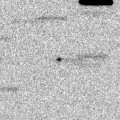
|
Now it is 16.8 mag (Jan. 25, ATLAS-HKO, Haleakala). It is observable at 16.5 mag in good condition from January to March.
Date(TT) R.A. (2000) Decl. Delta r Elong. m1 Best Time(A, h)
Jan. 28 12 7.87 24 25.1 0.341 1.237 131 16.6 3:41 ( 0, 79)
Feb. 4 12 32.93 26 22.0 0.340 1.238 131 16.5 3:38 ( 0, 81)
|
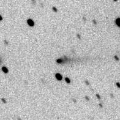
|
Now it is 16.4 mag (Jan. 19, Toshihiko Ikemura, Hirohisa Sato). It is observable at 16-17 mag in excellent condition from autumn to winter.
Date(TT) R.A. (2000) Decl. Delta r Elong. m1 Best Time(A, h)
Jan. 28 4 1.81 -0 6.5 3.058 3.511 109 16.6 19:33 ( 0, 55)
Feb. 4 4 3.71 0 26.0 3.154 3.516 103 16.6 19:07 ( 0, 56)
|
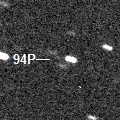
|
Now it is 16.9 mag (Jan. 25, Toshihiko Ikemura, Hirohisa Sato). It is observable at 16.5 mag in good condition in spring. It locates somewhat low in the Southern Hemisphere.
Date(TT) R.A. (2000) Decl. Delta r Elong. m1 Best Time(A, h)
Jan. 28 8 34.24 27 39.0 1.382 2.359 170 16.7 0:09 ( 0, 83)
Feb. 4 8 28.45 28 10.8 1.377 2.344 165 16.6 23:31 ( 0, 83)
|
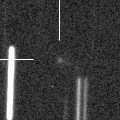
|
Now it is 16.9 mag (Jan. 21, Toshihiko Ikemura, Hirohisa Sato). It will brighten up to 13 mag in summer. In the Northern Hemisphere, it stays observable in good condition for a long time. In the Southern Hemisphere, it is not observable until August.
Date(TT) R.A. (2000) Decl. Delta r Elong. m1 Best Time(A, h)
Jan. 28 9 57.11 70 15.7 1.707 2.429 126 17.0 1:33 (180, 55)
Feb. 4 9 14.12 75 2.8 1.689 2.358 121 16.9 0:25 (180, 50)
|

|
Now it is 16.9 mag (Jan. 20, ATLAS Chile). Very far object. It stays 16-17 mag for a long time from 2021 to 2026. In the Southern Hemisphere, it stays observable in good condition for a long time. In the Northern Hemisphere, it is not observable at all.
Date(TT) R.A. (2000) Decl. Delta r Elong. m1 Best Time(A, h)
Jan. 28 5 50.07 -76 1.8 10.519 10.430 82 16.9 21:18 ( 0,-21)
Feb. 4 5 37.66 -75 36.8 10.506 10.424 82 16.9 20:38 ( 0,-21)
|
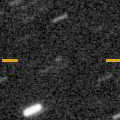
|
Appearing in the morning sky. It stays observable at 14-15 mag from spring to autumn. It locates somewhat low in the Northern Hemisphere.
Date(TT) R.A. (2000) Decl. Delta r Elong. m1 Best Time(A, h)
Jan. 28 17 7.82 -11 48.4 3.729 3.208 51 17.0 5:34 (308, 26)
Feb. 4 17 17.17 -12 13.9 3.634 3.188 55 16.9 5:30 (311, 28)
|
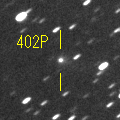
|
It brightened up to 15.3 mag in last winter (Jan. 12, 2022, H. Nohara). Now it is fading. It has already faded down to 17.2 mag (Jan. 28, Toshihiko Ikemura, Hirohisa Sato). It will be observable at 17 mag in good condition in next winter. It locates low in the Southern Hemisphere.
Date(TT) R.A. (2000) Decl. Delta r Elong. m1 Best Time(A, h)
Jan. 28 10 19.16 25 53.9 3.634 4.550 155 17.0 1:53 ( 0, 81)
Feb. 4 10 16.00 26 48.5 3.625 4.569 161 17.0 1:23 ( 0, 82)
|
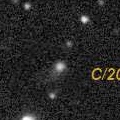
|
Now it is 17.0 mag (Jan. 21, Toshihiko Ikemura, Hirohisa Sato). It stays 17 mag and observable in good condition for a long time until 2023 summer.
Date(TT) R.A. (2000) Decl. Delta r Elong. m1 Best Time(A, h)
Jan. 28 13 31.40 6 8.2 8.536 8.890 108 17.1 5:05 ( 0, 61)
Feb. 4 13 29.22 6 38.5 8.426 8.896 115 17.1 4:35 ( 0, 62)
|

|
It brightened very rapidly up to 15.5 mag from last autumn to last winter (Nov. 2, 2021, Toshihiko Ikemura, Hirohisa Sato). Now it is fading slowly. It has already faded down to 16.7 mag (Jan. 19, ATLAS Chile).
Date(TT) R.A. (2000) Decl. Delta r Elong. m1 Best Time(A, h)
Jan. 28 6 14.35 9 35.7 3.723 4.555 143 17.2 21:45 ( 0, 65)
Feb. 4 6 12.28 9 44.9 3.807 4.575 136 17.3 21:15 ( 0, 65)
|
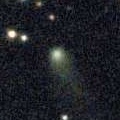
|
Now it is 17.1 mag (Jan. 27, Toshihiko Ikemura, Hirohisa Sato). Fading slowly. In the Southern Hemisphere, it is not observable after this.
Date(TT) R.A. (2000) Decl. Delta r Elong. m1 Best Time(A, h)
Jan. 28 17 57.71 43 36.7 6.242 6.015 72 17.2 5:34 (241, 45)
Feb. 4 18 4.91 44 37.6 6.246 6.048 73 17.3 5:30 (240, 48)
|

|
Now it is 17.1 mag (Jan. 9, D. Buczynski). Fading slowly. In the Northern Hemisphere, it stays observable in good condition for a long time. In the Southern Hemisphere, it is not observable after this.
Date(TT) R.A. (2000) Decl. Delta r Elong. m1 Best Time(A, h)
Jan. 28 18 13.61 65 57.2 9.646 9.674 88 17.3 5:34 (209, 43)
Feb. 4 18 17.93 66 40.4 9.659 9.690 88 17.4 5:30 (208, 44)
|
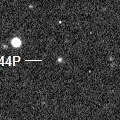
|
Now it is 17.5 mag (Jan. 18, Toshihiko Ikemura, Hirohisa Sato). It is observable at 17 mag in good condition in winter. It locates somewhat low in the Southern Hemisphere.
Date(TT) R.A. (2000) Decl. Delta r Elong. m1 Best Time(A, h)
Jan. 28 5 50.51 26 11.6 3.122 3.930 140 17.3 21:21 ( 0, 81)
Feb. 4 5 48.61 26 6.7 3.196 3.932 132 17.4 20:52 ( 0, 81)
|

|
Now it is 17.8 mag (Jan. 24, ATLAS Chile). Very large comet. It is expected to brighten up to 14 mag in 2031. In the Southern Hemisphere, it stays observable in good condition for a long time. In the Northern Hemisphere, it is not observable until 2030.
Date(TT) R.A. (2000) Decl. Delta r Elong. m1 Best Time(A, h)
Jan. 28 2 27.64 -59 45.9 18.320 18.052 72 17.4 18:51 ( 7, -5)
Feb. 4 2 28.07 -59 28.8 18.327 18.027 70 17.4 18:57 ( 11, -6)
|

|
Now it is 17.4 mag (Jan. 18, Toshihiko Ikemura, Hirohisa Sato). It stays 17 mag for a long time from 2023 to 2024. It is observable in good condition in the Northern Hemisphere. It locates low in the Southern Hemisphere.
Date(TT) R.A. (2000) Decl. Delta r Elong. m1 Best Time(A, h)
Jan. 28 2 23.23 27 54.0 6.887 7.043 95 17.6 18:51 ( 63, 76)
Feb. 4 2 25.24 27 56.9 6.984 7.029 88 17.6 18:57 ( 76, 70)
|

|
It has not been observed yet in this apparition. In the last apparition, it had faded before the perihelion passage. If it becomes as bright as its last apparition, it will brighten up to 17 mag. It stays observable in good condition for a long time.
Date(TT) R.A. (2000) Decl. Delta r Elong. m1 Best Time(A, h)
Jan. 28 13 56.52 -0 3.2 2.587 2.926 100 17.8 5:30 ( 0, 55)
Feb. 4 14 2.01 0 5.7 2.478 2.907 105 17.7 5:08 ( 0, 55)
|

|
Now it is 17.6 mag (Jan. 22, iTelescope Observatory, Siding Spring). It is observable at 17.5 mag in good condition in winter.
Date(TT) R.A. (2000) Decl. Delta r Elong. m1 Best Time(A, h)
Jan. 28 8 51.47 -0 22.6 2.551 3.497 160 17.7 0:26 ( 0, 55)
Feb. 4 8 47.90 -0 13.7 2.545 3.498 162 17.7 23:50 ( 0, 55)
|
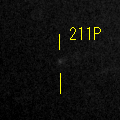
|
Now it is 18.4 mag (Jan. 25, Toshihiko Ikemura, Hirohisa Sato). It brightens up to 17.5 mag from January to February. It locates somewhat low in the Southern Hemisphere.
Date(TT) R.A. (2000) Decl. Delta r Elong. m1 Best Time(A, h)
Jan. 28 12 2.73 19 9.4 1.675 2.446 132 17.7 3:36 ( 0, 74)
Feb. 4 12 3.46 20 33.4 1.635 2.461 138 17.7 3:09 ( 0, 75)
|

|
It brightened up to 14 mag in 2021. Now it is fading. It has already faded down to 17.2 mag (Jan. 21, Toshihiko Ikemura, Hirohisa Sato). It will be fainter than 18 mag in March. It is already unobservable in the Southern Hemisphere.
Date(TT) R.A. (2000) Decl. Delta r Elong. m1 Best Time(A, h)
Jan. 28 23 30.77 17 4.7 7.372 6.856 55 17.7 18:51 ( 86, 36)
Feb. 4 23 33.98 17 31.5 7.496 6.895 49 17.8 18:57 ( 91, 30)
|

|
Now it is 17.9 mag (Jan. 17, A. Diepvens). It stays 17.5 mag until spring. It is observable in good condition in the Northern Hemisphere. It is not observable in the Southern Hemisphere.
Date(TT) R.A. (2000) Decl. Delta r Elong. m1 Best Time(A, h)
Jan. 28 23 7.22 80 20.5 2.813 3.146 100 17.7 18:51 (169, 39)
Feb. 4 0 7.81 80 19.1 2.822 3.139 99 17.7 18:57 (170, 40)
|
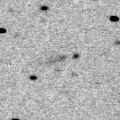
|
Now it is 18.6 mag (Jan. 21, Toshihiko Ikemura, Hirohisa Sato). It stays observable at 18 mag in good condition from January to March.
Date(TT) R.A. (2000) Decl. Delta r Elong. m1 Best Time(A, h)
Jan. 28 10 31.53 12 58.9 3.307 4.206 152 17.8 2:05 ( 0, 68)
Feb. 4 10 28.99 13 24.6 3.261 4.202 160 17.8 1:35 ( 0, 68)
|
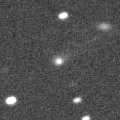
|
It brightened up to 15.9 mag in 2022 spring (May 5, Toshiyuki Takahashi). In 2023, it is observable at 17.5 mag in spring.
Date(TT) R.A. (2000) Decl. Delta r Elong. m1 Best Time(A, h)
Jan. 28 16 6.67 -22 39.3 5.190 4.831 63 18.0 5:34 (328, 25)
Feb. 4 16 11.70 -22 57.3 5.095 4.837 69 17.9 5:30 (332, 27)
|
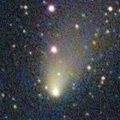
|
It brightened up to 10.4 mag from June to July (July 22, Ken-ichi Kadota). Now it is fading. Appearing in the morning sky in the Souther Hemisphere. It was originally predicted as 15 mag now. But actually, now it is very faint as 18.4 mag (Jan. 2, Martin Masek). It will never be observable again in the Northern Hemisphere.
Date(TT) R.A. (2000) Decl. Delta r Elong. m1 Best Time(A, h)
Jan. 28 20 1.33 -64 26.3 3.420 2.833 46 19.2 5:34 (330,-31)
Feb. 4 20 25.53 -64 1.2 3.476 2.912 48 19.5 5:30 (329,-31)
|
|
![]()
 77P/Longmore
77P/Longmore C/2021 S3 ( PanSTARRS )
C/2021 S3 ( PanSTARRS ) C/2020 R7 ( ATLAS )
C/2020 R7 ( ATLAS ) C/2021 G2 ( ATLAS )
C/2021 G2 ( ATLAS ) 117P/Helin-Roman-Alu 1
117P/Helin-Roman-Alu 1 73P/Schwassmann-Wachmann 3
73P/Schwassmann-Wachmann 3 119P/Parker-Hartley
119P/Parker-Hartley C/2020 S4 ( PanSTARRS )
C/2020 S4 ( PanSTARRS ) C/2020 Y2 ( ATLAS )
C/2020 Y2 ( ATLAS ) C/2022 E2 ( ATLAS )
C/2022 E2 ( ATLAS ) 204P/LINEAR-NEAT
204P/LINEAR-NEAT 61P/Shajn-Schaldach
61P/Shajn-Schaldach 285P/LINEAR
285P/LINEAR 116P/Wild 4
116P/Wild 4 P/2022 L3 ( ATLAS )
P/2022 L3 ( ATLAS ) C/2021 C5 ( PanSTARRS )
C/2021 C5 ( PanSTARRS ) C/2018 U1 ( Lemmon )
C/2018 U1 ( Lemmon ) C/2022 A3 ( Lemmon-ATLAS )
C/2022 A3 ( Lemmon-ATLAS ) C/2022 L2 ( ATLAS )
C/2022 L2 ( ATLAS ) 263P/Gibbs
263P/Gibbs 408P/2020 M7 ( Novichonok-Gerke )
408P/2020 M7 ( Novichonok-Gerke ) 94P/Russell 4
94P/Russell 4 C/2022 W3 ( Leonard )
C/2022 W3 ( Leonard ) C/2019 E3 ( ATLAS )
C/2019 E3 ( ATLAS ) 199P/Shoemaker 4
199P/Shoemaker 4 402P/2020 Q3 ( LINEAR )
402P/2020 Q3 ( LINEAR ) C/2020 F2 ( ATLAS )
C/2020 F2 ( ATLAS ) P/2021 N2 ( Fuls )
P/2021 N2 ( Fuls ) C/2020 H6 ( ATLAS )
C/2020 H6 ( ATLAS ) C/2019 O3 ( Palomar )
C/2019 O3 ( Palomar ) 244P/Scotti
244P/Scotti C/2014 UN271 ( Bernardinelli-Bernstein )
C/2014 UN271 ( Bernardinelli-Bernstein ) C/2021 S4 ( Tsuchinshan )
C/2021 S4 ( Tsuchinshan ) 280P/Larsen
280P/Larsen P/2021 V2 ( Fuls )
P/2021 V2 ( Fuls ) 211P/Hill
211P/Hill C/2020 F5 ( MASTER )
C/2020 F5 ( MASTER ) C/2022 W2 ( ATLAS )
C/2022 W2 ( ATLAS ) 452P/2022 B5 ( Sheppard-Jewitt )
452P/2022 B5 ( Sheppard-Jewitt ) 99P/Kowal 1
99P/Kowal 1 C/2021 P4 ( ATLAS )
C/2021 P4 ( ATLAS )![]()


























































